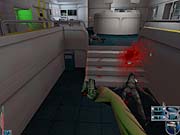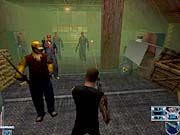With last year's horror-themed action-adventure game The Devil Inside, designer Hubert Chardot attempted to reclaim the "survival horror" genre that he arguably started when he created Alone in the Dark--the game that largely inspired Capcom's hugely successful Resident Evil series. Unfortunately, The Devil Inside, despite having some original ideas and gameplay elements, failed to make much of an impact. Evidently undaunted, Chardot is back again this year with another horror-themed game, From Dusk Till Dawn. And though it features some really interesting new ideas for the genre, its technical problems and overall lack of polish outweigh its few strengths.

From Dusk Till Dawn shares its title, a battle against a horde of vampires, and its lead character, Seth Gecko, with the 1996 Robert Rodriguez film, but that's about it. The game takes place on a floating prison barge called The Rising Sun, on which Seth Gecko is being held, pending execution. Within the first five minutes of play, vampires overrun the ship, and Gecko is released, bitten by a vampire, and exorcised by the prison's priest. From that point on, it's an almost nonstop gun battle against the undead as Seth attempts to escape.
As expressed in the gameplay of From Dusk Till Dawn, the best idea that Chardot has for the future of survival-horror games is the elimination of the simplistic, generally inane collection and item-manipulation puzzles that have become a staple of the genre. Instead, From Dusk Till Dawn's focus is exclusively on combat. In fact, Seth can't even jump, eliminating the possibility of even those types of "puzzles" that rely on fancy footwork. Every element of the game revolves around fighting. Its two subgames, which both occur several times, are a mounted Gatling gun mode, reminiscent of Wizard Works' simple shooter Beachhead 2000, and a sniper mode that's a lot like Virtua Cop and other light-gun games.
What differentiates this unyielding focus on combat from other pure combat games is From Dusk Till Dawn's other standout concept: the band of survivors. Though it's a staple of zombie and vampire movies, including the game's inspiration, the gradual accumulation of a ragtag group of allies has been effectively absent from the survival-horror genre. Though the game doesn't quite pull it off, it at least makes the attempt. As you make your way through the ship, you'll come across survivors, both singly and in groups. Instead of running away, dying, or disappearing through some other convenient plot contrivance, they're each incorporated into the story and will follow you throughout the rest of the game. Though they come and go as the plot progresses, and though you're sometimes required to go somewhere alone, in a given battle, you may have as many as five or six autonomous characters helping you fight the undead.
The game also incorporates the classic horror concept of holing up. Instead of simply and inexorably pressing forward, you and the other survivors will sometimes need to stay put and defend an area from an onslaught. Often, one member of the group will need to perform some action while the rest of you keep him or her safe for a period of time. It's such an effective way to enliven the traditional switch-flipping and valve-turning activities that are a staple of action games, and such a natural fit in a horror-themed game, that it's a wonder it hasn't been implemented more often.
Unfortunately, the technical reality of the game doesn't live up to its ambitions. Most importantly, movement is simply off. Everything feels sluggish and a little floaty, as if Seth Gecko were a helium-filled parade float. Control in the Gatling gun mode is especially bad. This is a huge problem for an action game. Crashes to the desktop are also common, as are scripting errors. At one point, a computer-controlled character got stuck performing some action necessary to trigger forward progress, and a saved game from several levels and an hour before had to be reloaded to replay the entire sequence. There were a few other instances like this, so it's an especially good idea to keep a rotating sequence of saved games.

The environmental graphics are pretty good. The engine is capable of producing a kind of pastel, soft-edged look that's at least a little different from--if not more attractive than--other games. The character models, on the other hand, uniformly border on terrible. Perhaps to permit a large number of characters to appear onscreen at once--sometimes as many as 10 or 15--the models are all simplistic. There are a couple of decent character effects, such as a type of vampire that exhibits the effectively creepy ability to crab-walk across the ceiling and a neat Predator-like camouflage effect, but for the most part, everything has the simple geometry of a felt puppet with a scary face painted on it.
The cutscenes and all of the dialogue are completely nonsensical. Sometimes, scenes appear to have no other purpose than to show someone slowly walking across a room, and characters often communicate in a series of unrelated, sarcastic non sequiturs. Here's a transcript of one complete conversation:
Guy with half-eaten arm: "We have to get to the workshop!"
Seth: "Why, you want me to fix your problem?"
Guy with half-eaten arm: "A group of mechanics is trapped down there!"
Seth: "Pretty interesting, that thing."
Seth also has an arsenal of 10-or-so catchphrases that he frequently recites during combat for no real reason. These too--like the classic "Looks like we're gonna have to play this one tight!"--often don't make a lot of sense.
The storytelling is so incompetent that it eventually becomes sort of charming. However, the same can't be said for the control problems and general lack of technical polish. From Dusk Till Dawn features some great ideas, all subverted by sloppy implementation. Hopefully, some developer will steal the good parts and use them in a better game.